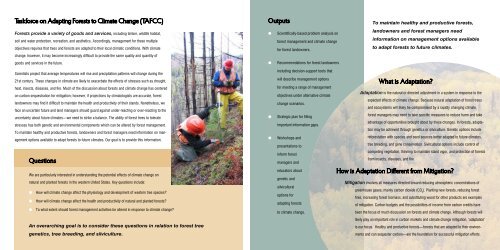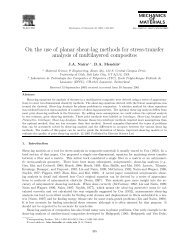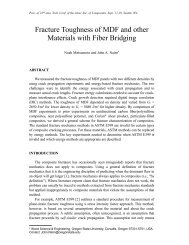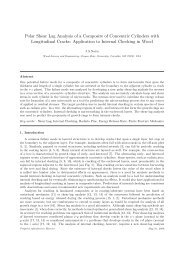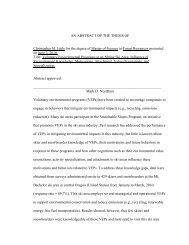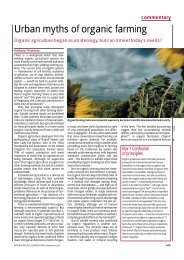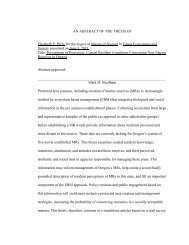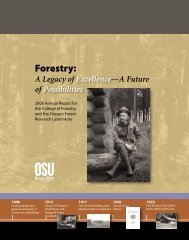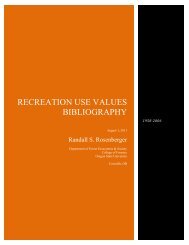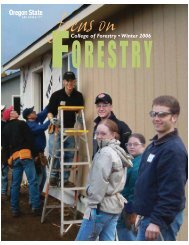brochure - Taskforce on Adapting Forests to Climate Change
brochure - Taskforce on Adapting Forests to Climate Change
brochure - Taskforce on Adapting Forests to Climate Change
- No tags were found...
You also want an ePaper? Increase the reach of your titles
YUMPU automatically turns print PDFs into web optimized ePapers that Google loves.
<str<strong>on</strong>g>Taskforce</str<strong>on</strong>g> <strong>on</strong> <strong>Adapting</strong> <strong>Forests</strong> <strong>to</strong> <strong>Climate</strong> <strong>Change</strong> (TAFCC)<strong>Forests</strong> provide a variety of goods and services, including timber, wildlife habitat,soil and water protecti<strong>on</strong>, recreati<strong>on</strong>, and aesthetics. Accordingly, management for these multipleobjectives requires that trees and forests are adapted <strong>to</strong> their local climatic c<strong>on</strong>diti<strong>on</strong>s. With climatechange, however, it may become increasingly difficult <strong>to</strong> provide the same quality and quantity ofgoods and services in the future.Outputsl Scientifically-based problem analysis <strong>on</strong>forest management and climate changefor forest landowners.l Recommendati<strong>on</strong>s for forest landownersTo maintain healthy and productive forests,landowners and forest managers needinformati<strong>on</strong> <strong>on</strong> management opti<strong>on</strong>s available<strong>to</strong> adapt forests <strong>to</strong> future climates.Scientists project that average temperatures will rise and precipitati<strong>on</strong> patterns will change during the21st century. These changes in climate are likely <strong>to</strong> exacerbate the effects of stresses such as drought,heat, insects, diseases, and fire. Much of the discussi<strong>on</strong> about forests and climate change has centered<strong>on</strong> carb<strong>on</strong> sequestrati<strong>on</strong> for mitigati<strong>on</strong>; however, if projecti<strong>on</strong>s by clima<strong>to</strong>logists are accurate, forestlandowners may find it difficult <strong>to</strong> maintain the health and productivity of their stands. N<strong>on</strong>etheless, weface an uncertain future and land managers should guard against under-reacting or over-reacting <strong>to</strong> theuncertainty about future climates—we need <strong>to</strong> strike a balance. The ability of forest trees <strong>to</strong> <strong>to</strong>leratestresses has both genetic and envir<strong>on</strong>mental comp<strong>on</strong>ents which can be altered by forest management.To maintain healthy and productive forests, landowners and forest managers need informati<strong>on</strong> <strong>on</strong> managemen<strong>to</strong>pti<strong>on</strong>s available <strong>to</strong> adapt forests <strong>to</strong> future climates. Our goal is <strong>to</strong> provide this informati<strong>on</strong>.Questi<strong>on</strong>sWe are particularly interested in understanding the potential effects of climate change <strong>on</strong>natural and planted forests in the western United States. Key questi<strong>on</strong>s include:l How will climate change affect the physiology and development of western tree species?l How will climate change affect the health and productivity of natural and planted forests?l To what extent should forest management activities be altered in resp<strong>on</strong>se <strong>to</strong> climate change?llincluding decisi<strong>on</strong>-support <strong>to</strong>ols thatwill describe management opti<strong>on</strong>sfor meeting a range of managemen<strong>to</strong>bjectives under alternative climatechange scenarios.Strategic plan for fillingimportant informati<strong>on</strong> gaps.Workshops andpresentati<strong>on</strong>s <strong>to</strong>inform forestmanagers andeduca<strong>to</strong>rs aboutgenetic andsilviculturalopti<strong>on</strong>s foradapting forests<strong>to</strong> climate change.What is Adaptati<strong>on</strong>?Adaptati<strong>on</strong> is the natural or directed adjustment in a system in resp<strong>on</strong>se <strong>to</strong> theexpected effects of climate change. Because natural adaptati<strong>on</strong> of forest treesand ecosystems will likely be compromised by a rapidly changing climate,forest managers may need <strong>to</strong> take specific measures <strong>to</strong> reduce harm and takeadvantage of opportunities brought about by these changes. In forests, adaptati<strong>on</strong>may be achieved through genetics or silviculture. Genetic opti<strong>on</strong>s includereforestati<strong>on</strong> with species and seed sources better adapted <strong>to</strong> future climates,tree breeding, and gene c<strong>on</strong>servati<strong>on</strong>. Sivilcultural opti<strong>on</strong>s include c<strong>on</strong>trol ofcompeting vegetati<strong>on</strong>, thinning <strong>to</strong> maintain stand vigor, and protecti<strong>on</strong> of forestsfrom insects, diseases, and fire.How is Adaptati<strong>on</strong> Different from Mitigati<strong>on</strong>?Mitigati<strong>on</strong> involves all measures directed <strong>to</strong>ward reducing atmospheric c<strong>on</strong>centrati<strong>on</strong>s ofgreenhouse gases, mainly carb<strong>on</strong> dioxide (CO 2). Planting new forests, reducing forestfires, increasing forest biomass, and substituting wood for other products are examplesof mitigati<strong>on</strong>. Carb<strong>on</strong> budgets and the possibilities of income from carb<strong>on</strong> credits havebeen the focus of much discussi<strong>on</strong> <strong>on</strong> forests and climate change. Although forests willAn overarching goal is <strong>to</strong> c<strong>on</strong>sider these questi<strong>on</strong>s in relati<strong>on</strong> <strong>to</strong> forest treelikely play an important role in carb<strong>on</strong> markets and climate change mitigati<strong>on</strong>, ‘adaptati<strong>on</strong>’is our focus. Healthy and productive forests—forests that are adapted <strong>to</strong> their envir<strong>on</strong>-genetics, tree breeding, and silviculture.ments and can sequester carb<strong>on</strong>—are the foundati<strong>on</strong> for successful mitigati<strong>on</strong> efforts.


